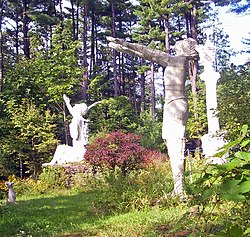Emile Brunel Studio and Sculpture Garden
|
Emile Brunel Studio and Sculpture Garden
|
|

Natache (left), Moon Haw Haw and
Great White Spirit, 2008 |
|
| Location | Boiceville, NY |
|---|---|
| Nearest city | Kingston |
| Coordinates | 41°59′59″N 74°15′50″W / 41.99972°N 74.26389°WCoordinates: 41°59′59″N 74°15′50″W / 41.99972°N 74.26389°W |
| Area | 1.3 acres (5,300 m2) |
| Built | 1918–47 |
| Architect | Emile Brunel |
| Architectural style | Arts and Crafts |
| NRHP Reference # | 99000909 |
| Added to NRHP | 1999 |
The Emile Brunel Sculpture Garden and Studio, also known as the Totem Indian Trading Post, Le Chalet Indien, and Brunel Park, is located on Da Silva Road, just off the NY 28 state highway, in Boiceville, Town of Olive, New York, United States. It consists of seven sculptures and three buildings.
Brunel was a French immigrant and artist who had become fascinated by the Native American tribes of the West during his travels there in the early 20th century. After a successful career as a photographer he bought a tract of land in the Catskills and built a studio residence and a resort on it, decorated with sculptures inspired by the Native American art he had seen. The resort closed and the statues were relocated soon thereafter when Route 28 was widened through it at the end of World War II, but the sculpture garden remained a popular roadside attraction afterwards.
In 1929 Brunel began construction of a studio residence on the site in the "neo-rustic" or French Arts and Craft style. His wife and daughter (both named Gladyse) kept the sculpture garden maintained after his death in 1944, operating a nearby souvenir shop until 1985. The artist's home and studio remain intact, and were listed on the National Register of Historic Places in 1999.
The studio and sculpture garden are located on a 1.3-acre (5,300 m2) lot at the intersection of Da Silva and Route 28, approximately a half-mile (1 km) south of the small hamlet of Boiceville. The area is primarily wooded, with the land generally sloping westward towards Esopus Creek. There are some other houses on the former resort property uphill and to the east, and along Route 28 to the south. The land across the highway is undeveloped since it is owned by the New York City Department of Environmental Protection as a buffer for Ashokan Reservoir to the south.
...
Wikipedia
